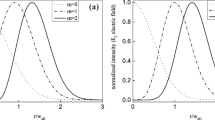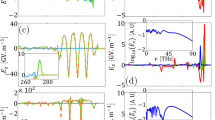Abstract
The theory of terahertz (THz) waves generation at the incidence of the focused p-polarized laser pulse on the plasma boundary is developed. The angular, spectral, and energy characteristics of the THz signal are studied as the function of the focusing degree and the incidence angle of laser radiation, as well as the plasma density. The frequency dependence of the THz signal energy is considered and it is established that the emission spectrum contains the broad line, and its position for tight focusing of laser radiation is determined by its reciprocal duration. The radiation pattern of the THz pulse is studied and it is shown that the decrease in the size of the laser pulse focal spot leads to the increase in the angle of radiation with respect to the normal to the plasma boundary, and for the tight focusing of the laser pulse, THz waves are emitted almost along the plasma-vacuum interface. It is established that the energy of the THz pulse noticeably increases when the p-polarized laser pulse is incident almost along the normal onto the near-critical plasma at the angle of total reflection, and the transverse size of the laser pulse decreases. It is shown that the emission of high-power THz pulses with the sufficiently high conversion rate occurs at the almost normal incidence of ultrashort tightly focused laser radiation on the boundary of near-critical plasma with rare electron collisions.






Similar content being viewed by others
References
H. Song, T. Nagatsuma, Handbook of Terahertz Technologies: Devices and Applications (Jenny Stanford Publishing, New York, 2015)
X.-C. Zhang, A. Shkurinov, Y. Zhang, Nat. Photonics 11, 16 (2017)
C. Weiss, R. Wallenstein, R. Beigang, Appl. Phys. Lett. 77, 4160 (2000)
F. Kadlec, P. Kuzel, J.-L. Coutaz, Opt. Lett. 29, 2674 (2004)
F. Kadlec, P. Kuzel, J.-L. Coutaz, Opt. Lett. 30, 1402 (2005)
G.H. Welsh, K. Wynne, Opt. Express 17, 2470 (2009)
E.V. Suvorov, R.A. Akhmedzhanov, D.A. Fadeev, I.F. Ilyakov, V.A. Mironov, B.V. Shishkin, Opt. Lett. 37, 2520 (2012)
A. Gopal, S. Herzer, A. Schmidt, P. Singh, A. Reinhard, W. Ziegler, D. Brommel, A. Karmakar, P. Gibbon, U. Dillner, T. May, H.-G. Meyer, G.G. Paulus, Phys. Rev. Lett. 111, 074802 (2013)
H. Hamster, A. Sullivan, S. Gordon, W. White, R.W. Falcone, Phys. Rev. Lett. 71, 2725 (1993)
N. Yugami, T. Higashiguchi, H. Gao, S. Sakai, K. Takahashi, H. Ito, Y. Nishida, T. Katsouleas, Phys. Rev. Lett. 89, 065003 (2002)
D. Dorranian, M. Starodubtsev, H. Kawakami, H. Ito, N. Yugami, Y. Nishida, Phys. Rev. E 68, 026409 (2003)
P. Sprangle, J.R. Penano, B. Hafizi, C.A. Kapetanakos, Phys. Rev. E 69, 066415 (2004)
C.B. Schroeder, E. Esarey, J. van Tilborg, W.P. Leemans, Phys. Rev. E 69, 016501 (2004)
J. van Tilborg, C.B. Schroeder, C.V. Filip, C. Tóth, C.G.R. Geddes, G. Fubiani, R. Huber, R.A. Kaindl, E. Esarey, W.P. Leemans, Phys. Rev. Lett. 96, 014801 (2006)
T. Nagashima, H. Hirayama, K. Shibuya, M. Hangyo, M. Hashida, S. Tokita, S. Sakabe, Opt. Express 17, 8807 (2009)
F. Jahangiri, M. Hashida, T. Nagashima, S. Tokita, M. Hangyo, S. Sakabe, Appl. Phys. Lett. 99, 261503 (2011)
T.I. Oh, Y.S. You, N. Jhajj, E.W. Rosenthal, H.M. Milchberg, K.Y. Kim, New J. Phys. 15, 075002 (2013)
A.V. Balakin, V.B. Gildenburg, V.M. Gordienko, N.A. Kuzechkin, T.A. Semenov, P.M. Solyankin, I.A. Pavlichenko, Y. Zhu, A.P. Shkurinov, JOSA B 38, 3515 (2021)
C. Vicario, A.V. Ovchinnikov, S.I. Ashitkov, M.B. Agranat, V.E. Fortov, C.P. Hauri, Opt. Lett. 39, 6632 (2014)
C. Vicario, M. Jazbinsek, A.V. Ovchinnikov, O.V. Chefonov, S.I. Ashitkov, M.B. Agranat, C.P. Hauri, Opt. Express 23, 4573 (2015)
A.A. Frolov, Plasma Phys. Control. Fusion 62, 0950020 (2020)
A.A. Frolov, Phys. Plasmas 28, 013104 (2021)
A.A. Frolov, J. Plasma Phys. 89, 905890107 (2023)
F.W.J. Olver, Asymptotics and Special Functions (CRC Press, London, New York, 1997)
J. Limpouch, V.T. Tikhonchuk, J. Dostál, R. Dudžák, M. Krupka, N.G. Borisenko, J. Nikl, A.A. Akunets, L.A. Borisenko, V.G. Pimenov, Plasma Phys. Control. Fusion 62, 035013 (2020)
Ph. Nicolaï, M. Olazabal-Loumé, S. Fujioka, A. Sunahara, N. Borisenko, S. Gus’kov, A. Orekov, M. Grech, G. Riazuelo, C. Labaune, J. Velechowski, V. Tikhonchuk, Phys. Plasmas 19, 113105 (2012)
V.P. Silin, Sov. Phys. JETP 20, 1510 (1964)
C. Chudoba, J.G. Fujimoto, E.P. Ippen, H.A. Haus, U. Morgner, F.X. Kärtner, V. Scheuer, G. Angelow, T. Tschudi, Opt. Lett. 26, 292 (2001)
A.V. Ovchinnikov, S.I. Ashitkov, M.B. Agranat, D.S. Sitnikov, Quantum Electron. 38, 325 (2008)
Author information
Authors and Affiliations
Corresponding author
Ethics declarations
Conflict of interest
The author has no conflicts to disclose.
Data Availability Statement
The data that supports the findings of this study are available within the article. This manuscript has no associated data or the data will not be deposited. [Authors’ comment: Since this is a theoretical work, there are no external data associated with this manuscript.]
Appendix: Boundary value problem for p-polarized laser pulse
Appendix: Boundary value problem for p-polarized laser pulse
To solve the boundary value problem when the p-polarized laser pulse (1) is incident on a semi-bounded plasma, we will use the Maxwell equations
where \({\mathbf{E}}_{L} \left( {{\mathbf{r}},t} \right),\;{\mathbf{B}}_{L} \left( {{\mathbf{r}},t} \right)\) are the electric and magnetic fields of laser radiation, and the electron velocity \({\mathbf{V}}_{L} \left( {{\mathbf{r}},t} \right)\) is determined from the equation
In this case, from the set of equations (A1), (A2) follows the equation for the \(y\)-component of the laser pulse magnetic field \(B_{L} \left( {{\mathbf{r}},t} \right) = {\mathbf{e}}_{y} \cdot {\mathbf{B}}_{L} \left( {{\mathbf{r}},t} \right)\)
where \(\omega_{p}\) is the plasma frequency, \(\Delta\) is the Laplace operator.
To solve Eq. (A3), we will use the Fourier transform in time and coordinate
Then from (A3) follows the ordinary differential equation for the Fourier transform of the magnetic field
whose solution, taking into account the continuity of the tangential components of the field \(E_{L,x} \left( {\omega ,k_{x} ,z} \right)\) [see Eq. (4)] and \(B_{L} \left( {\omega ,k_{x} ,z} \right)\), has the form
where the reflection coefficient \(R\left( {\omega ,k_{x} } \right)\) and transmission coefficient \(T\left( {\omega ,k_{x} } \right)\) for p-polarized radiation determined by formula (6). Equating the expression \(B_{0} \left( {\omega ,k_{x} } \right)\exp \left\{ {iz\sqrt {\left( {{{\omega^{2} } \mathord{\left/ {\vphantom {{\omega^{2} } {c^{2} }}} \right. \kern-0pt} {c^{2} }}} \right) - k_{x}^{2} } } \right\}\) from (A6) to the Fourier transform of the incident pulse (1) near the boundary \(z = 0\), for \(B_{0} \left( {\omega ,k_{x} } \right)\) we obtain the following formula
Substituting formula (A7) into (A6) and using the inverse Fourier transform (A4), we obtain Eqs. (2), (3), (5) for the magnetic field of p-polarized laser radiation in vacuum and plasma.
Rights and permissions
Springer Nature or its licensor (e.g. a society or other partner) holds exclusive rights to this article under a publishing agreement with the author(s) or other rightsholder(s); author self-archiving of the accepted manuscript version of this article is solely governed by the terms of such publishing agreement and applicable law.
About this article
Cite this article
Frolov, A.A. Terahertz waves emission from plasma under action of p-polarized tightly focused laser pulse. Eur. Phys. J. D 77, 109 (2023). https://doi.org/10.1140/epjd/s10053-023-00693-7
Received:
Accepted:
Published:
DOI: https://doi.org/10.1140/epjd/s10053-023-00693-7




